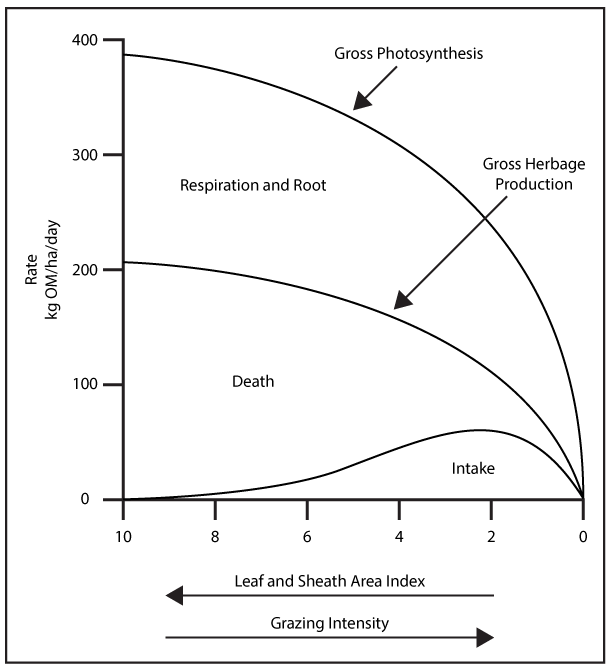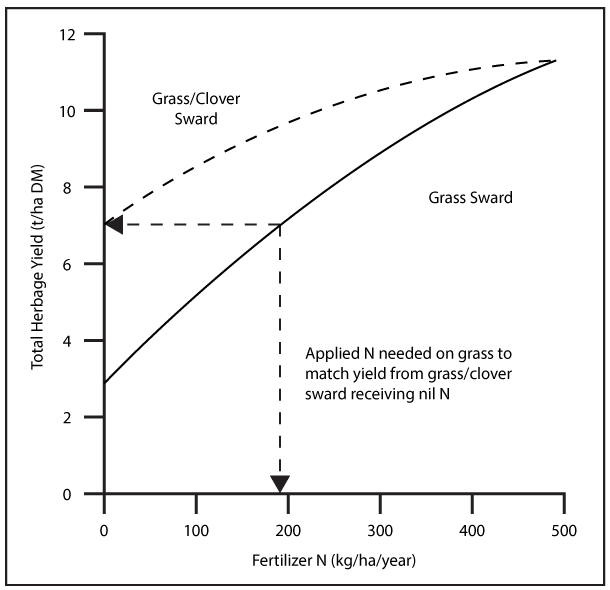Utilization of Forage
Forage is normally used in two different ways; either for grazing or for cutting. The same field may be used for both purposes in the same season. Both uses have a number of different aspects to be considered.
Grazing
Grazing is by far the cheapest way of utilizing forage. In many parts of the world it is also the only way when the pastures are either too dry, wet, or hilly to be utilized by machines. In many cases, grazing is carried out extensively with very low input. Good forage management is an essential part of intensive grazing management. Grazing can be done in different ways:
-
Continuous Grazing
-
Rotational Grazing
In continuous grazing livestock are in the same area for a long period of time. The stocking rate is high, and the number of fields limited.

The Effect of Continuous Stocking on the Balance Between Photosynthesis, Gross Tissue Production, Herbage Intake and Death.
Source of Information: Parsons et al. Iin Frame: Improved Grassland Management, 1992.
Cutting
In rotational grazing the area is divided into a number of paddocks. Livestock graze each paddock for a set number of days before moving on to the next paddock. Any surplus of grass is used for silage or hay and the stocking rate is high. The number of paddocks can vary from 2 to 4 and up to 10 to 14. Stripe grazing is a system of rotational grazing, where the livestock are offered new grass every day; one stripe which gives the necessary feed for one day of grazing.
For cutting, the principal ways of utilization are:
-
Silage
-
Hay
-
Green Chop
Silage is used for winter feed. Often the amount of grass used for silage is only the surplus coming from the grazing fields in spring/early summer, but some farmers also have silage as their main grass crop. Making silage is a science of its own. Prewilting is very important as well as having dry weather conditions when harvesting. The silage should be free of soil and other foreign matters. The grass should be quick and efficiently collected and packed so that the grass is left completely airtight for the ensiling process. During this process the sugar in the grass is turned into different acids that preserve the grass. Sometimes the process is supported by adding an inoculate to start the process. Grasses are easier to ensile than legumes because of their higher sugar content.
Hay is another way of preserving grass for winter. Here the principle is to make the grass so dry that it can be stored for a long time without being degraded. Wet climates in many areas make hay production difficult because haymaking requires continuous days of dry weather.
Green Chop is a relatively expensive way to feed livestock, but ensures almost the same quality of feed every day. Fresh grass is chopped each day and transported to the livestock that are barn fed or in a small paddock.
General Management
A lot of measures must be taken by the farmer during the summer in order to keep the feeding constant and adequate. Important factors are:
-
The Right Grass Mixture for the Purpose
-
Good Establishment
-
Fertilization, Irrigation, Weed Control, Etc.
-
Cutting at the Right Time (Quality)
-
Grazing Management: Plant Height, Clover/Grass Relation, Rotation Between Paddocks
-
Reseeding/Overseeding or Renovation when Necessary

Effect of Incereasing Fertilizer N Application on Grass and Grass/Clover Swards.
From Frame: Improved Grassland Management 1992.
Stand Renovation
Forage is slowly degrading over time. In the beginning, it consists of only planted species. After some time, depending on the climate, management etc., the field is taken over by weeds or wild species of grass, which yield less and have lower quality than the cultivated species. Renovation is therefore necessary. Forage in rotation is routinely renewed every 2 or 3 years. This provides a constantly good stand with high yields and good quality. Renovation is normally done by plowing and seeding the newest variety.
Overseeding
Overseeding may renew forages which aren't in rotations due to difficult soil conditions. This is done by special machines, cutting away some of the old stand and placing the seed in a slot or narrow seedbed. For overseeding to be successful, reduce competition from the old stand by cutting, grazing, and/or chemicals. Important factors are:
-
Control Weeds
-
Not Suitable on Heavy or Rocky Soils
-
Good Soil Conditions (Moisture, Etc.)
-
Good Machinery
-
Rapidly Establishing Species
-
Graze After Drilling
